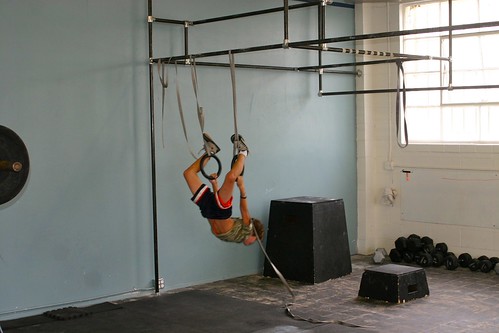Icy Hot
“Coe”
Ten rounds for time of:
95 pound Thruster, 10 reps
10 Ring push-ups
Mikko Salo 9:55, Peter Egyed 11:07, Kristan Clever 11:28 (65lbs), Rebecca Voigt 11:46 (65lbs), Kim Malz 13:49 (65lbs), Elyse Umeda 14:34 (65lbs). Post time to comments.
Nicole Carroll performing ring push up variations wmv/ mov, try a couple, but don’t forget the same push up standards apply wmv/ mov!
The basics of the infamous Thruster wmv/ mov, to perform this movement well, you need to be comfortable in the front squat rack position wmv/ mov and jump the bar off the shoulder.
*************************************************
When you have an injury, its important to ice it, everyone knows that! But what about if its an old injury, does ice still work, or is heat better? Maybe there’s a combo that works best, hmmmm. I was discussing this with Lindsey last month and she was kind enough to find this article:
The quick and dirty of Hot vs. Cold
There is often confusion following an injury concerning whether to apply cold therapy or whether to warm the area. The answer depends on the type of injury you have sustained.
Acute Injuries
Acute injuries are those which result from traumatic incidents (a fall, twisting movement or direct blow for example) and are immediately painful. When an acute injury first occurs, bleeding, inflammation, swelling and pain must all be controlled. Ice should be applied as soon as possible in order to cool the tissues, reduce their metabolic rate and nerve conduction velocity and cause vasoconstriction of the surrounding blood vessels.
Ice should remain in contact for up to 20 minutes at a time (dependant on the size of the area being treated and the depth of the injured structure) and be re-applied regularly, every 2-3 hours. Following approximately the first 3-5 days of an acute injury, once bleeding has stopped and there are no signs of inflammation, you may wish to alternate cold and heat treatments. That is apply cold for 10 minutes, followed immediately by 10 minutes of heat. Doing this causes massive increases in blood flow to the area as the vasoconstriction caused by cooling reverses when heat is applied, resulting in an influx of blood to the damaged tissues. Ensure all bleeding has stopped before applying this technique. Blood is vitally important in providing all of the energy and nutrients that the body needs for repair.
Chronic Injuries
Chronic injuries usually do not present with a sudden onset. They tend to gradually build up over a period of days, weeks or longer and are often caused by overuse or biomechanical abnormality. A chronic injury can also be caused by an acute injury which fails to heal due to a lack of, or inappropriate treatment. Heat therapy should be applied for 15-20 minutes in the form of hot water bottles, a warm damp towel, heat rub or commercially available heat pads. If using something such as a hot water bottle, ensure a suitable layer of protection is placed over the skin to prevent burns. In general heat should be used to treat chronic injuries, to help relax tight, aching muscles and joints, increase elasticity of ligaments and tendons and increase the blood flow to the area. Heat therapy can also be used prior to exercise in chronic injuries to warm the muscles and increase flexibility. The only time ice should be used on chronic injuries is after exercise, to reduce any residual swelling.
















